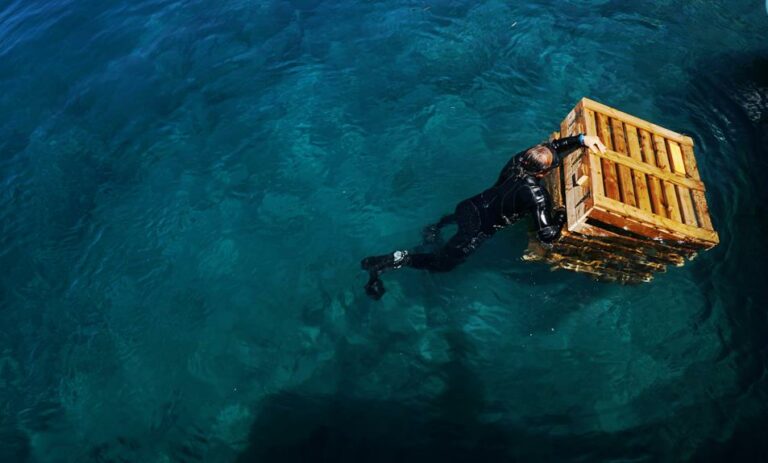Did you know that the primary material used in scuba diving wetsuits is neoprene, a synthetic rubber foam known for its excellent insulation properties?
Neoprene is often laminated with a nylon-based material, providing durability and flexibility.
In this article, we will delve into the fascinating world of wet suit materials, exploring their composition, function, and variations.
Discover how wetsuits work to keep divers warm in colder conditions, the benefits of titanium lining, and the different types of wetsuits available to cater to various diving needs.
Key Takeaways
- Scuba diving wetsuits are typically made of neoprene, a synthetic rubber foam.
- Neoprene has tiny bubbles for insulation and can be laminated with a nylon-based material.
- Gas blown neoprene with nitrogen gas bubbles is the most durable type, while chemical blown neoprene is softer but less durable.
- Wetsuits work by trapping a thin layer of water between the skin and neoprene, which is warmed by the diver's body heat to keep them warm underwater.
Wet Suit Material Options
When considering wet suit material options, it is important to understand the various choices available for scuba diving enthusiasts.
One important factor to consider is wetsuit material thickness. The thickness of the neoprene used in a wetsuit affects its insulation properties. Thicker neoprene provides better insulation and is ideal for colder water temperatures.
Another important option to consider is the use of gas blown neoprene. Gas blown neoprene is a type of neoprene that has nitrogen gas bubbles incorporated into it. This type of neoprene is known for its durability and longevity. It is more resistant to abrasions and tears compared to other types of neoprene.
Additionally, gas blown neoprene provides better buoyancy and flexibility, allowing divers to move more freely underwater.
How Do Wetsuits Keep You Warm
Wetsuits keep you warm by trapping a thin layer of water between your skin and the neoprene material. This design has several advantages that contribute to its effectiveness in maintaining body heat:
- Insulation: Neoprene foam contains thousands of tiny bubbles that act as insulators, reducing heat loss from the body to the surrounding water. This helps to create a barrier against the cold water temperatures.
- Water Circulation: The thin layer of water that is trapped between the skin and the neoprene material acts as a barrier, preventing water from circulating freely around the body. This stagnant layer of water is gradually warmed by the body heat, providing a continuous source of warmth.
- Thermal Efficiency: Neoprene foam has excellent thermal properties, which helps to retain the heat generated by the body. Compared to alternative materials for wetsuits, such as rubber or fabric, neoprene is highly efficient in maintaining body temperature in cold water conditions.
Benefits of Titanium Lining
Titanium-lined wetsuits offer enhanced thermal insulation for divers by reflecting heat back to the body. The titanium lining acts as a barrier, preventing heat loss and keeping the body warm in cold water. This advanced material is advantageous for divers who engage in deep-sea exploration or extended diving sessions, as it provides superior warmth and comfort.
The main advantage of titanium lining is its ability to retain body heat, allowing divers to stay in the water for longer periods without experiencing discomfort or hypothermia. Additionally, titanium-lined wetsuits are more durable and resistant to wear and tear compared to traditional neoprene wetsuits.
However, the main disadvantage of titanium-lined wetsuits is their higher cost. Due to the added technology and materials involved, these wetsuits tend to be more expensive than regular neoprene wetsuits.
Despite this drawback, the benefits of titanium lining make it a popular choice for serious divers looking to maximize their thermal insulation and overall comfort during underwater adventures.
Exploring Wetsuit Variations
As we delve into the topic of wetsuit variations, it is important to consider the diverse range of options available to cater to the specific needs and preferences of divers. Here are three key aspects to explore:
- Wetsuit Color Options:
Wetsuits are no longer limited to basic black. Divers now have the choice of vibrant colors and designs. This not only adds a touch of personal style but also makes divers easier to spot underwater, enhancing safety and visibility.
- Wetsuits for Different Diving Needs:
There are different types of wetsuits designed to meet specific diving requirements. Some wetsuits are specifically tailored for men, women, or children, ensuring a proper fit and comfort. Additionally, wetsuits may vary in thickness and insulation levels, catering to different water temperatures and diving conditions.
- Customization and Special Features:
Manufacturers offer customization options, allowing divers to add features such as reinforced knees, extra pockets, or detachable hoods to their wetsuits. These additional features enhance functionality and convenience, making the diving experience more enjoyable.
Additional Resources and Engagement Opportunities
How can divers access additional resources and engage with the diving community?
One way is through the provided sections on the website, which offer a wealth of information on buying a wetsuit, putting it on, repairing it, and caring for it. These guides include valuable insights on wetsuit sizes, fit, and thickness. The website also provides recommendations for high-end, mid-range, and cheap wetsuits, allowing divers to make informed decisions. Moreover, practical tips for wetsuit maintenance can be found, ensuring that divers can prolong the lifespan of their gear.
In addition to the informative articles, readers can engage with the diving community through the website's comment section and various social media platforms. These platforms include Facebook, Twitter, Pinterest, Tumblr, Reddit, WhatsApp, and Messenger.
Frequently Asked Questions
Are There Any Eco-Friendly Alternatives to Neoprene for Wetsuit Material?
Eco-friendly alternatives to neoprene for wetsuit material are being explored. Various substitutes, such as natural rubber and recycled materials, are being tested for their thermal insulation and durability. These alternatives aim to reduce the environmental impact of wetsuit production.
How Do Wetsuits Handle Water Pressure at Deeper Depths?
Wetsuits are designed to handle water pressure at deeper depths through their construction. The neoprene material, with its thousands of tiny bubbles, provides insulation and helps maintain the diver's body heat, keeping them warm.
Can Wetsuits Protect Against Jellyfish Stings or Other Sea Creature Encounters?
Wetsuits provide limited protection against jellyfish stings and sea creature encounters due to their neoprene material. However, specialized suits with thicker layers or additional coatings can offer increased defense.
What Are the Advantages of Using a Drysuit Instead of a Wetsuit?
Advantages of drysuits include superior insulation, as they keep the diver completely dry. This allows for longer dives in colder waters. Drysuits are also more versatile, as they can be worn with various undergarments for different temperatures. When comparing drysuits and wetsuits, the main difference is that wetsuits rely on a thin layer of water to insulate, while drysuits keep the diver dry.
Is It Possible to Customize the Design or Color of a Wetsuit for Personal Preference?
Customization options for wetsuits vary depending on the manufacturer, with availability in different designs and colors. Prices may be higher for customized wetsuits, and limitations may exist based on the manufacturer's capabilities. Benefits include personalization, but drawbacks may include longer delivery times.

